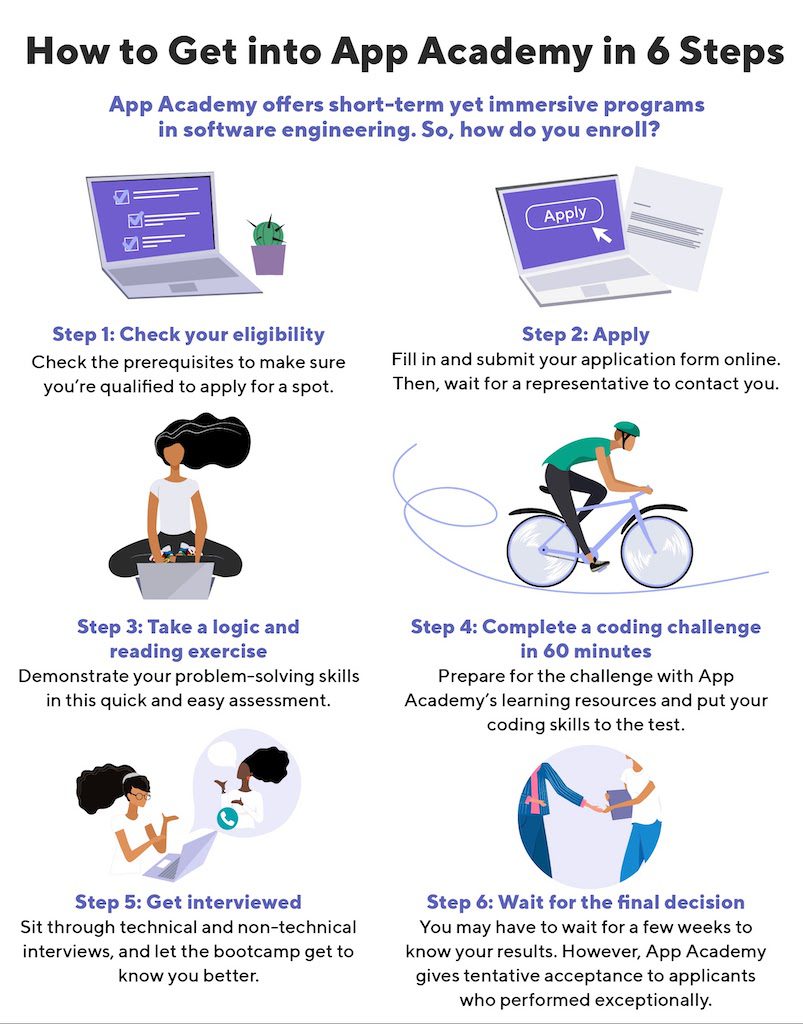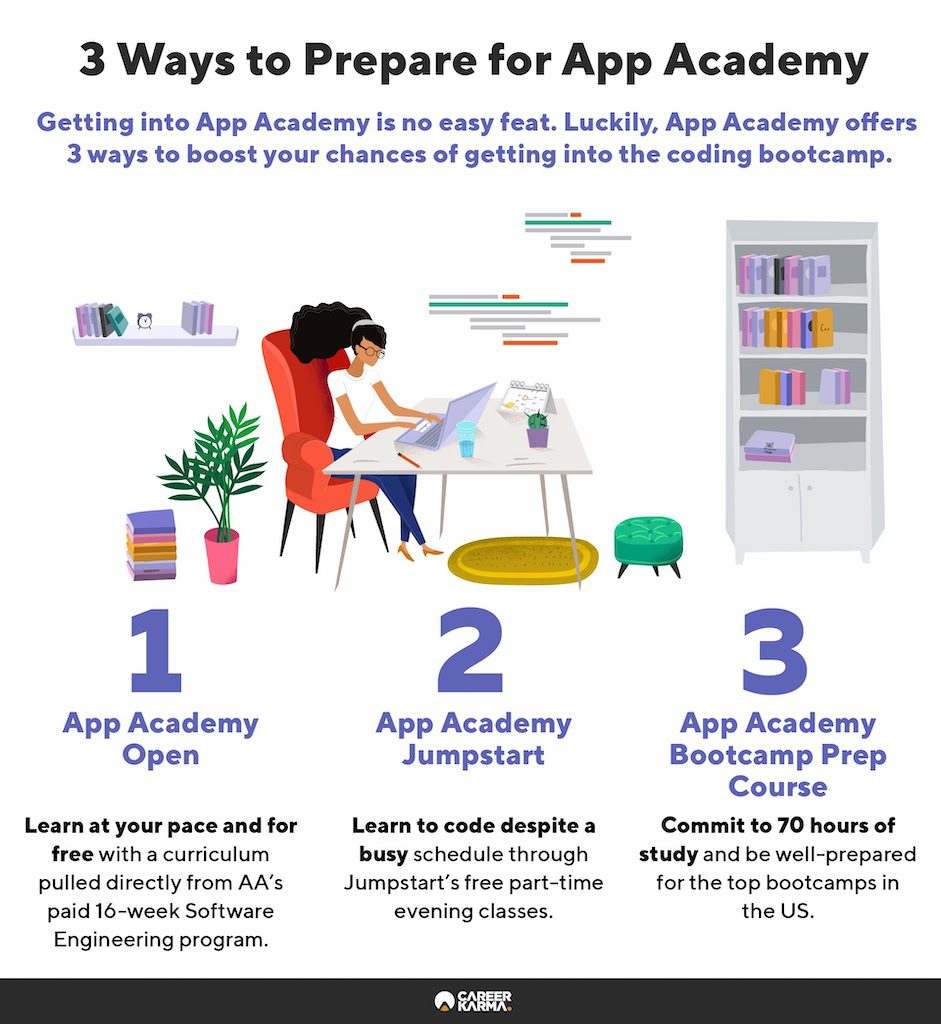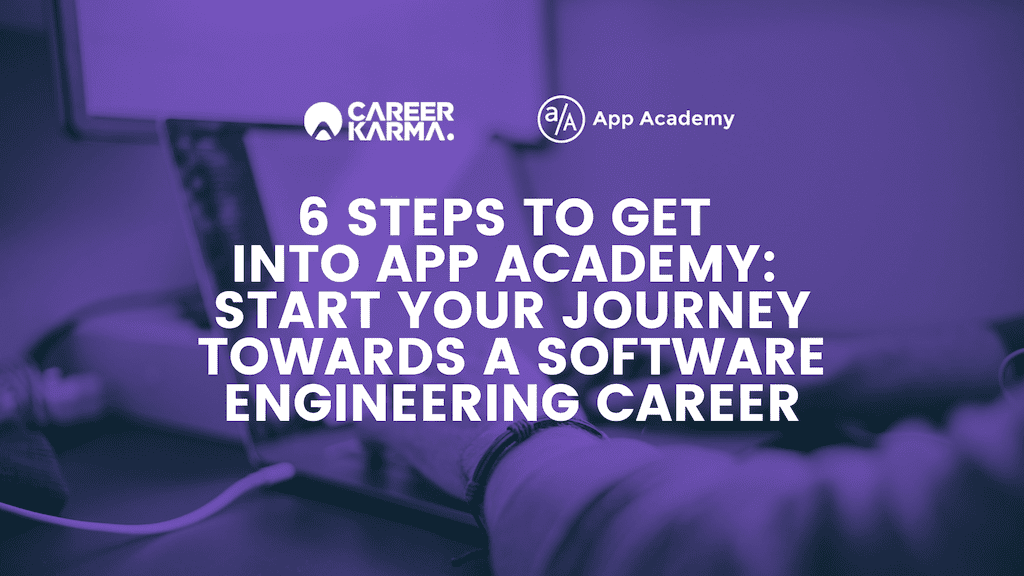App Academy is a top-tier coding bootcamp founded in 2012 and offers students the opportunity to switch to a software engineering career. For this reason, it accommodates all categories of students, whether they have prior programming experience or not.
App Academy focuses on teaching industry-relevant skills. Its curriculum is extensive on JavaScript, Ruby on Rails, SQL, Flux, React, JQuery, and Redux. It also prepares students for real-life work conditions by employing several pair-programming exercises and capstone projects.
Following its mission to bridge the gap in tech education, the bootcamp offers several payment options. Using Income Share Agreement or deferred payment plans, learners can begin their program without paying tuition until they land a job that pays above a set minimum income threshold.
With all these said, how do you get through the doors of App Academy?
App Academy is a software engineering bootcamp that has helped learners get hired in companies around the world.
Contact App Academy today.A Complete Guide to the App Academy Application Process

To begin your journey at App Academy, you must complete App Academy’s application process, which takes a couple of weeks to complete. Here is a step-by-step guide to the App Academy application process:
Step 1: Check Your Eligibility
Before beginning the application process, you should ensure that you are qualified to apply for a spot at App Academy’s Software Engineering immersive. Here are the prerequisites.
- You must be aged 18 and above.
- While you don’t need prior experience in coding, you must have a high school diploma or the equivalent.
Aside from those general requirements, each program has some unique conditions. For example:
- The 16-week In-person Full-Time Software Engineering Immersive program only admits residents in San Francisco or New York.
- The 24-week Online Full-time Software Engineering Immersive course accepts applications from local and international students, except for New York residents. However, international students must have permanent work authorization in the United States.
- For both courses, you need to be available for live classes. They run from 8 am to 5 pm PST for the virtual courses and 9 am to 6 pm PST for the in-person course.
Step 2: Submit an Application Form
Once you’re sure you check the prerequisites, access the application form from App Academy’s website. The application form will need your basic information, including your name, date of birth, academic and professional experience, among others.
App Academy will also ask if you have any programming experience. Note, however, that whether you have prior coding knowledge or not, it will not affect your chances of getting into the program.
After submitting your application, an admission officer will reach out to you via a phone call to communicate the details of your screening process.
Step 3: Take a Logic and Reading Exercise
The screening process kicks off with a logic and reading exercise intended to assess your verbal and typing skills, math and logic skills, and spatial reasoning. To excel, applicants should have basic problem-solving skills, and they must be able to type quickly enough to keep up with the material.
According to App Academy, it is an easy task and most people ace it.
Step 4: Complete a Coding Challenge in 60 minutes
The coding challenge aims to assess your knowledge of programming. Before the challenge, you would receive 50 to 60 hours’ worth of learning materials to prepare you for a series of challenges. Even if you are a beginner, you would be able to take the test.
The learning materials include live learning lectures with technical instructors. Together, they cover the basics of HTML & CSS, Git, and Boolean Algebra. You would also get access to a forum that enables you to ask questions and receive feedback.
Each time you complete a challenge, you would receive feedback from the admissions and instructions teams. The process can be new to beginners, so adequate support is available to guide applicants through the entire process.
The challenge may take place around one to three weeks after the reading exercise.
Step 5: Sit Through Technical and Non-technical Interviews
Consider the technical and non-technical interviews at App Academy as job interviews. It would include five behavioral questions which test your interview skills, teamwork, and other interpersonal skills.
The order in which the interviews take place depends on the course you’re applying for. The non-technical/fit interview can come first if you apply for the 24-week course or later if you are applying for the 16-week course.
Both interviews last for 25 minutes, on average, and will be conducted by an App Academy alum. It would also be on a recorded Zoom call so you can watch yourself, receive feedback, and learn from it.
Step 6: Sit Back and Wait for the Final Decision
After the interview process, applicants may have to wait for a few weeks to know if they were selected. However, App Academy gives tentative acceptance to applicants who performed very exceptionally through all the tasks.
Three Tips to Boost Your Chances of Getting into App Academy

As with several other top-tier bootcamps, App Academy is quite selective when accepting fresh students. That reflects in its admission rate, which is about five percent. Hence, applicants must have excellent performances at all screening stages to get a place in the school.
Here are three tips to help boost your chances of getting into App Academy.
1. Learn to Code for Free with App Academy Open
App Academy Open is the bootcamp’s proprietary coding platform that offers a full-stack web development curriculum at a $0 price tag. The curriculum is exactly the same as App Academy’s paid in-person full-time program, but with the absence of some key features like live lectures, access to mentors and teaching assistants, pair programming, and so on.
That said, the App Academy Open doesn’t lose out on relevance. According to App Academy, about 4,000 have landed jobs after completing the Open program.
App Academy Open has three plans: the Free Plan, Mentorship Plan, and Full-Time Plan.
If you choose to go through the curriculum on your own, you can pick the Free Plan. That way, the program becomes quite similar to MOOCs. However, if you desire access to App Academy staff and instructors, the Mentorship and Full-Time Plans are better options.
The Mentorship Plan costs $29.99 a month, while the Full-Time Plan has multiple pricing options.
The most preferred is the deferred payment option which costs $500 upfront. Then, when you get a job, you will pay 17 percent of the first year’s salary over two years to cover the tuition. Learn more about App Academy Open here.
2. Attend App Academy JumpStart
App Academy JumpStart is a free part-time course with classes held in the evening. The course was created to help increase your chances of getting accepted into App Academy by preparing you for the coding challenge and the technical interview.
The course runs for two weeks and allows access to instructors who take you through the curriculum.
3. Enroll in App Academy’s Bootcamp Prep Course
App Academy Prep is a night-only program designed to amplify your acceptance into App Academy. It runs for four weeks and focuses heavily on JavaScript.
It costs $2,999 for the in-person course, while the online variant comes in different plans: $995, $1,795, and $3,795 packages. Each plan differs in the extensiveness of its curriculum.
Start Your Software Engineering Career with App Academy
Like other industry-leaders schools, App Academy’s admissions process is rigorous. So, applicants must put in a good front at every stage—from the reading and typing tests to the coding challenges and interviews. Once you get into the bootcamp, you can be among other App Academy students training for a well-paying career in software engineering. Talk to an Admissions specialist at App Academy and fit learning into your lifestyle.
About us: Career Karma is a platform designed to help job seekers find, research, and connect with job training programs to advance their careers. Learn about the CK publication.


